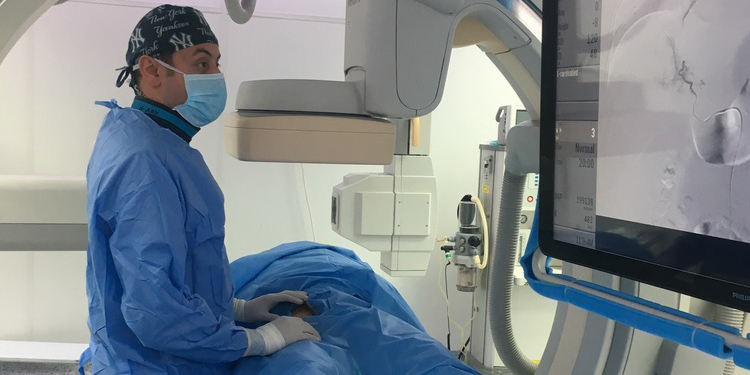
Overview
Understanding Renal Artery Stenosis - RAS (kidney artery): An In-Depth Overview
What is renal artery stenosis?
Renal Artery Stenosis (RAS) is the narrowing of one or both arteries supplying blood to the kidneys. It's often caused by atherosclerosis, fibromuscular dysplasia, or aneurysms. This condition reduces blood flow to the kidneys, impacting their ability to filter waste and regulate fluids. RAS can lead to hypertension, chronic kidney disease, and, in severe cases, kidney failure. Renovascular hypertension (RVH) is a specific type of high blood pressure associated with RAS. Early detection and management are crucial for preventing complications.
Symptoms of Renal Artery Stenosis (RAS):
Early Stages (Often Asymptomatic):
- High blood pressure that is difficult to control.
- Sudden onset hypertension before age 30 or after age 50.
Advanced Symptoms:
- Treatment-resistant high blood pressure.
- Audible whooshing sound (bruit) over kidneys.
- Elevated protein levels in urine.
- Fluid overload and body swelling.
Decreased Kidney Function Manifestations:
- Changes in urination.
- Edema (swelling), typically in legs, feet, or ankles.
- Fatigue.
- Headaches.
- Difficulty concentrating.
Consider RAS if:
- Unexplained high blood pressure, especially in individuals over 50.
- High blood pressure is unresponsive to multiple medications.
Recognizing these symptoms is crucial for timely intervention to prevent complications such as kidney failure and cardiovascular issues.
Causes and Diagnoses of Renal Artery Disease:
Causes of Renal Artery Disease:
- Atherosclerosis: A gradual process where plaque (fat, cholesterol, and calcium deposits) builds up inside arteries, leading to blockages. This accumulation restricts blood flow to the kidneys, impairing their normal function.
- Fibromuscular Dysplasia: An uncommon condition involving abnormal tissue growth in the renal arteries, causing narrowing and potentially limiting blood supply to the kidneys.
- Aneurysms: Weakened, bulging areas in the artery walls, which, if present in the renal arteries, can result in the artery's rupture, posing a serious threat.
Risk Factors of Renal Artery Disease:
Examination by a physician helps determine strategies to reduce the risk of renal artery disease, considering:
- Blood Clotting Disorders: Conditions that affect normal blood clotting mechanisms.
- Cigarette Smoking: A major risk factor contributing to the development and progression of arterial diseases.
- Diabetes: Chronic high blood sugar levels can contribute to arterial damage.
- Heart Disease: Conditions affecting the heart can impact overall cardiovascular health, including the renal arteries.
- High Blood Cholesterol: Elevated levels of cholesterol may contribute to atherosclerosis.
- High Blood Pressure: Hypertension can strain and damage the arteries, including those leading to the kidneys.
Diagnostic Tests of Renal Artery Disease:
Advanced technologies are employed for accurate diagnosis, including:
- Computed Tomography Angiography (CTA): Detailed imaging to visualize renal arteries and identify any blockages or abnormalities.
- Magnetic Resonance Angiogram (MRA): Utilizes magnetic fields to create detailed images of renal arteries, aiding in the assessment of blood flow.
- Ultrasound: High-frequency sound waves create images of renal blood flow, providing a non-invasive means of evaluating kidney function and identifying potential issues.
Take the first step towards kidney health – Book an appointment with Dr. Hosni, the leading Interventional Radiologist in the UAE. Your well-being is our priority. Act now to ensure a healthier tomorrow.
Renal Artery Disease Treatments:
Treatment strategies for renal artery disease are diverse, covering medical therapy, surgical interventions, and minimally invasive procedures. Here's a detailed breakdown:
- Medications:
- Statins: Medications to regulate cholesterol levels, promoting cardiovascular health.
- Blood Pressure Medicine: Essential for controlling and maintaining optimal blood pressure levels.
- Thrombolytic Medicine: Designed to dissolve blood clots, facilitating improved blood flow.
- Open Surgery:
- Endarterectomy: A surgical procedure involving the removal of plaque from the blocked artery, restoring normal blood flow.
- Bypass: This surgical method entails placing a bypass graft to redirect blood flow around arterial blockages or replace an aneurysm.
- Minimally Invasive Techniques:
- Angioplasty: A less invasive procedure using a catheter or hollow tube to widen an artery and enhance blood flow. Subtypes include:
- Balloon Angioplasty: Inflating a small balloon inside the blocked artery to open the obstructed area.
- Atherectomy: Employing a catheter-mounted device to "shave away" the blocked area inside the artery.
- Stenting: Placing a tiny coil that expands and remains inside the artery to maintain an open passage.
- Angioplasty: A less invasive procedure using a catheter or hollow tube to widen an artery and enhance blood flow. Subtypes include:
Comprehensive Care Approach:
Treatment plans are tailored based on individual cases, considering factors such as the extent and location of artery blockages.
Consultation with a healthcare professional is essential to determine the most suitable treatment strategy.
Regular follow-ups and monitoring are crucial to assess treatment effectiveness and make adjustments if needed.
Make an appointment with your reliable interventional radiologist, Dr. Hosni, to start a customized kidney wellness journey.
